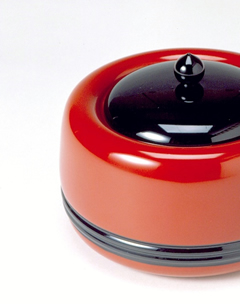RYUKYU Shikki (Lacquerware)

It is thought that the origins of Ryukyu lacquerware may date back to the 1300s, when the first tributes were sent to China. In 1609, the court of Shuri established a lacquerware workshop, leading to the production of goods that were of a high technical and artistic standard. In addition, a private industry developed in the Wakasamachi district of Naha.
Most Ryukyu lacquerware is plain, with a simple polished top coat of vermilion or black. However, there are various examples with decorations, including Ryukyu's own tsuikin technique. Other techniques include chinkin, maki-e and raden, which uses mother-of-pearl. The core material is made from deigo, snowbell or bean tree wood, and pig’s blood is used as the undercoat. Raw lacquer is used for the final coat, giving the underlying vermilion an unsurpassed brilliance. Items produced today include decorative trays, bowls, plates and cups.
Feature
Most Ryukyu lacquerware is vermilion or black, and is made using the hana-nuri technique. Other techniques used to apply decoration include tsuikin, chinkin, hakue and raden. The base is made from the wood of native trees including deigo, snowbell and white cedar. The foundation is coated in pig’s blood (tonketsu) and other materials. Its magnificent vermilion color is particularly distinctive.
How to make
Tsuikin is a unique technique used to color Ryukyu lacquerware. A clay-like mixture of pigment and lacquer is thinned, shaped and fixed to the bowl, after which it is refined and finished.

